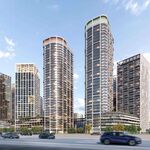freshcutgrass
Senior Member
I think the fact that “The City of Toronto has the lowest allocation of park space per person in Canada” is a pretty negative finding! Just look at the maps on page 15 and page 16 (http://torontocentreplan.org/wp-content/uploads/2012/07/july18_11wellesley.pdf). Thousands of people are moving to downtown but there has not been a corresponding increase in green spaces. It’s poor planning.
Note: Discussion continued from the "Theatre Park" thread.
Not that I don't think we need more parks & rec space, especially downtown....but many of those stats are very misleading and not as "negative" as you might think.
Of course Toronto would have lower park space per person, as it has higher densities, and higher density is the key to good urban living. But Toronto has over 1500 parks well spread through the whole city, and I doubt they count places like the entire Don Valley as a "park". And our parks are just more well used, which isn't a negative at all.
Of course Calgary is going to a higher allocation than Toronto...it's land mass at 825 sqkm, is considerably larger than Toronto, while it's population is only 1.2 million. It does not have dense neighbourhoods or downtown as Toronto has.
The Toronto Centre stats are a little misleading, as they do not include the large parks that are just on the other side of the street from the arbitrary borders used (Queens Park, UofT, Ramsden Park, Cawthra Park, Allen Gardens, Moss Park, St James Park).
Saying NYC has twice the park space as Toronto does isn't wrong, but all that park space is found at the extreme edges of the city where very few of the entire population have what anyone would consider convenient access. Try those numbers for Manhattan and see what happens. And when it comes to recreational facilities, Toronto decimates NYC in that regard.
But there is definitely room for improvement in downtown, where the development and population continues to increase at a blazing pace.
Hey...I have an idea. Would Toronto like another 215 acres of downtown parkland situated a few hundred metres from one of the densest neighbourhoods in the country and where lots of new development is continuing to take place?
It's already zoned parkland and is essentially already empty. We just need to tear down a fence that keeps the public from using it. We would also be saving ourselves millions of dollars in costs and helping the environment at the same time.
It's called Billy Bishop Airport, and it's high time we booted them out (and the TPA along with it)
Last edited:





